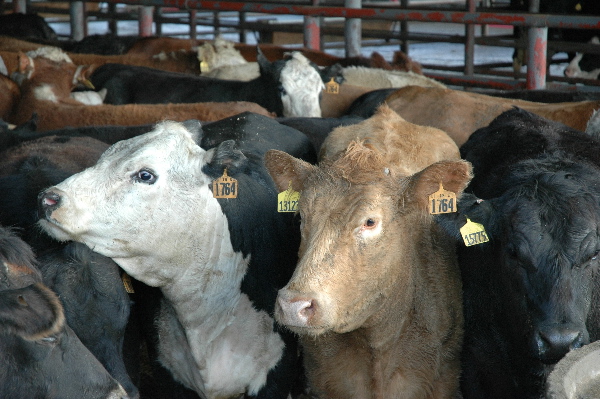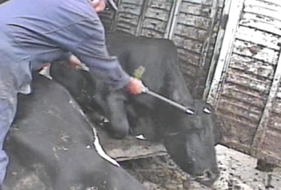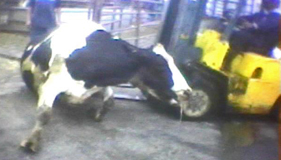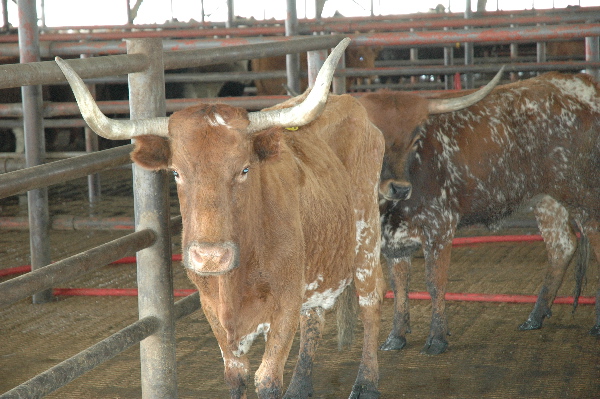From the Open-Publishing Calendar
From the Open-Publishing Newswire
Indybay Feature
Are Tumors, Abscesses, and Downed Cows in your Hamburger?
143 million pounds of recalled meat may be just the beginning. The story below calls into question the practices of a Fresno meat processing plant where workers say downer cows, tumors, and abscesses are being ground into hamburger. The general manager of the Fresno plant says the workers are wrong and that they would never do anything like that.

Are Tumors, Abscesses, and Downed Cows in your Hamburger?
By Mike Rhodes
Local and national media are reporting on the recall of 143 million pounds of meat from a southern California slaughterhouse. More than 70 school districts and social service agencies in the Central Valley ended up with some of that meat. But, the issue of contaminated meat might be a lot more problematic and local than we have been told. According to Steven Gomez*, who worked for six months at Cargill Regional Beef in Fresno, the practices that led to the current recall at the Hallmark Meat Company in southern California happens every day locally.
“They use downer cows all the time,” Gomez told me in an exclusive interview. Gomez said it was common practice for workers in the southwest Fresno slaughterhouse to hit downed cows with sticks and eventually pick them up with a fork lift to get them onto the kill floor. According to Karen Stump*, who also worked at Cargill, “they would shoot the cow because it couldn’t get up and then they would bring them into the kill room with a fork lift.” Both Gomez and Stump said those downer cows would be processed and put into the food stream with all of the other cows.
According to a statement from the Humane Society of the United States (HSUS), the group that uncovered the southern California incident that led to the current recall, “downer cows must not be used for food-plain and simple. As The HSUS video shows (see: http://www.indybay.org/newsitems/2008/02/19/18480414.php ), this is necessary to protect animals from suffering. As science has made clear, this is necessary to protect food safety. The practice of slaughtering downed cows is especially troubling now that the link between downed cattle and bovine spongiform encephalopathy (BSE), also known as mad cow disease, has been firmly established. Of the 15 known cases of BSE-infected animals discovered in North America, at least 12 involved downed animals.”
Derek Kennedy, vice president and general manager at the Fresno Cargill plant, which is located at Fig and North, insisted that they do not use downed cows at their facility. “If we have a downed cow it is sent to the rendering plant,” Kennedy said. He explained that an animal that is too sick to get up is euthanized, moved with a forklift, and eventually taken to a rendering plant. Kennedy did say that cattle are sometimes shot in the yard and taken into the kill room for processing. According to Kennedy, this happens if the animal is too big or its horns are too large for it to go through the chute. He suggested that my source for this story (Gomez and Stump) may have been confused about what they saw.
Gomez told me that the problems at the local slaughterhouse does not end with their use of downer cows. He said that the assembly line he worked on was sped up so fast that pieces of meat containing tumors, abscesses, and other growths would pass the line and end up in hamburger. On the line where the cows stomach was removed, he said that sometimes the intestine was accidentally cut open, resulting in fecal matter contaminating the meat.
Kennedy said that every employee on the line has the opportunity to shut it down if a bad piece of meat goes by. He said “if they’re not doing that they shouldn’t work here.” According to Kennedy, it would be rare if a tumor or abscess got on the line and that he would expect the work crew to see it, shut down the line, and decontaminate the area. He absolutely denied that tumors, abscesses, and other growths where in the hamburger coming from this plant.
The high speed of the line also resulted in what Gomez described as “work related injuries”. He said that “within the first months of employment I began to experience pain in both hands. Cramping and stiff joints caused my hands to ‘pop and lock.’ I was told that the job was ‘not easy’ and took ‘conditioning.’ I was advised that a couple of months of such labor would ‘condition’ my hands and body to perform duties safely and painlessly.”
Gomez said the on site nurse treated his complaints with hot wraps and Ibuprofen. He said “I was advised not to be concerned with the ‘popping and locking’ of my hands as it would pass as I ‘got used to the job.’ When I expressed my concerns to the on site nurse I was asked - ‘Why are you so fixated on the popping noise?’” Gomez resigned in late January 2008 because of the numbness in his hands and because he believed he was being harassed due to his complaints about working conditions.
When he called to tell me his story, Gomez was primarily focused on the unfair working conditions, how dismissive the on site nurse was of work related injuries, and how supervisors speed up the line to unsafe levels. When I asked him if he ever saw USDA inspectors looking out for bad meat or OSHA workers checking on working conditions he said that when tours would come through, the supervisors would slow down the line. “I remember one time when we had a tour coming through that my supervisor sent me home to put on a different pair of shoes.” He said that supervisors only slowed the line down and made sure everyone was wearing all of the necessary safety equipment when they had a special tour.
Kennedy said that they do slow down the line when there are tours of the plant, but he claimed that it was to protect the workers who might be distracted by the tour members. Kennedy did not give me a tour of the cutting line. I was however given a tour of the stock yard, shown a couple of long horned steer, and saw hides coming off a conveyor belt into a truck. Cargill even brought out Mark Klein, director of media relations, from Minneapolis Mn to answer any questions I might have but he would not show me the chute that was too small for the long horned steers.
On the same day of my tour of Cargill (February 25), State Senator Dean Florez held a hearing on the issue of meat contamination in Sacramento. Prior to the hearing, Florez said “As thousands of pounds of frozen ground beef sit ‘on hold’ in school cafeterias across the nation while the USDA determines whether or not it is safe for our children to eat, I have scheduled a hearing of the Senate Select Committee on Food-borne Illness into the events that got us into this situation, as well as other disturbing issues brought to light by the investigation.” The hearing attempted to answer the question: “Are we allowing E-Coli contaminated beef to enter California’s food supply?” Florez asked participants of several panels what, if anything, the state could do to respond to the recall and what could be done to prevent another incident.
The first testimony came from Dr. Michael Greger, the Director of Public Health and Animal Agriculture for the Humane Society of the United States. His testimony stated that “the horrific treatment of animals we documented is being downplayed as an unconscionable aberration—the work of just a handful of rogue employees. We do not believe this is an accurate characterization.” Greger concluded his testimony with the following: “we encourage your committee to recognize that this case demonstrates some deep and systemic flaws in USDA’s oversight of slaughter plants. USDA has an inherent conflict of interest, with its prime mission being to promote agriculture, a mission that seems too often to trump its other responsibilities.”
Florez expressed frustration with the job the USDA was doing to protect our food supply and asked several times if it would be a good idea to install video surveillance cameras at the state’s slaughterhouses. These cameras would monitor the facilities to guarantee the humane treatment of animals and to ensure that downer cows are not entering the food chain.
Two employees of the now shuttered southern California Hallmark Meat Company were charged on February 15 with animal cruelty in the aftermath the massive meat recall. "Americans know cruelty when they see it, and the HSUS investigation has outraged millions," said Wayne Pacelle, president and CEO of The Humane Society of the United States. "The suffering of animals shown in the HSUS video is beyond comprehension.”
After being provided videotaped evidence and a detailed report of the undercover investigation, San Bernardino County District Attorney Michael A. Ramos charged Daniel Ugarte Navarro with five felony counts under California's anti-cruelty statute and three misdemeanor counts alleging the use of a mechanical device to move "downer" cows, those unable to stand on their own. Convictions on the felony charges could bring a sentence up to 15 years in prison and $100,000 in fines, plus additional penalties on the misdemeanor charges. The second worker, Jose Luis Sanchez, was charged with three misdemeanors involving downers. He faces up to 18 months in jail and $3,000 in fines if convicted.
There is no way for the Community Alliance newspaper to verify the claims of former employees at Cargill or to know how well the company is able to keep all contaminants out of the food supply. That is the job of the USDA or the courts.
It is the job of the USDA to protect our food supplies. But with their failure to monitor the slaughterhouse in southern California, which resulted in the largest recall in US history, a lot of people are questioning how much we can trust the USDA. Why did it take a clandestine film crew to uncover this situation when the USDA was on site and supposedly monitoring the situation?
Repeated attempts by this newspaper to get a comment from a USDA inspector at the Cargill plant was unsuccessful. USDA representatives were invited but did not attend the legislative hearings in Sacramento.
Senator Dean Florez’s suggestion to put video surveillance cameras at all California slaughterhouses might not be a bad idea. Put the live video on the Internet so consumers can see for themselves that the cows being processed are being humanely treated and that no downer’s go into onto the kill floor. Until consumers can trust the USDA again, this might be the best we can hope for.
###
*Steven Gomez and Karen Stump are fictitious names. The author has changed the two whistle blowers names to protect their privacy.
By Mike Rhodes
Local and national media are reporting on the recall of 143 million pounds of meat from a southern California slaughterhouse. More than 70 school districts and social service agencies in the Central Valley ended up with some of that meat. But, the issue of contaminated meat might be a lot more problematic and local than we have been told. According to Steven Gomez*, who worked for six months at Cargill Regional Beef in Fresno, the practices that led to the current recall at the Hallmark Meat Company in southern California happens every day locally.
“They use downer cows all the time,” Gomez told me in an exclusive interview. Gomez said it was common practice for workers in the southwest Fresno slaughterhouse to hit downed cows with sticks and eventually pick them up with a fork lift to get them onto the kill floor. According to Karen Stump*, who also worked at Cargill, “they would shoot the cow because it couldn’t get up and then they would bring them into the kill room with a fork lift.” Both Gomez and Stump said those downer cows would be processed and put into the food stream with all of the other cows.
According to a statement from the Humane Society of the United States (HSUS), the group that uncovered the southern California incident that led to the current recall, “downer cows must not be used for food-plain and simple. As The HSUS video shows (see: http://www.indybay.org/newsitems/2008/02/19/18480414.php ), this is necessary to protect animals from suffering. As science has made clear, this is necessary to protect food safety. The practice of slaughtering downed cows is especially troubling now that the link between downed cattle and bovine spongiform encephalopathy (BSE), also known as mad cow disease, has been firmly established. Of the 15 known cases of BSE-infected animals discovered in North America, at least 12 involved downed animals.”
Derek Kennedy, vice president and general manager at the Fresno Cargill plant, which is located at Fig and North, insisted that they do not use downed cows at their facility. “If we have a downed cow it is sent to the rendering plant,” Kennedy said. He explained that an animal that is too sick to get up is euthanized, moved with a forklift, and eventually taken to a rendering plant. Kennedy did say that cattle are sometimes shot in the yard and taken into the kill room for processing. According to Kennedy, this happens if the animal is too big or its horns are too large for it to go through the chute. He suggested that my source for this story (Gomez and Stump) may have been confused about what they saw.
Gomez told me that the problems at the local slaughterhouse does not end with their use of downer cows. He said that the assembly line he worked on was sped up so fast that pieces of meat containing tumors, abscesses, and other growths would pass the line and end up in hamburger. On the line where the cows stomach was removed, he said that sometimes the intestine was accidentally cut open, resulting in fecal matter contaminating the meat.
Kennedy said that every employee on the line has the opportunity to shut it down if a bad piece of meat goes by. He said “if they’re not doing that they shouldn’t work here.” According to Kennedy, it would be rare if a tumor or abscess got on the line and that he would expect the work crew to see it, shut down the line, and decontaminate the area. He absolutely denied that tumors, abscesses, and other growths where in the hamburger coming from this plant.
The high speed of the line also resulted in what Gomez described as “work related injuries”. He said that “within the first months of employment I began to experience pain in both hands. Cramping and stiff joints caused my hands to ‘pop and lock.’ I was told that the job was ‘not easy’ and took ‘conditioning.’ I was advised that a couple of months of such labor would ‘condition’ my hands and body to perform duties safely and painlessly.”
Gomez said the on site nurse treated his complaints with hot wraps and Ibuprofen. He said “I was advised not to be concerned with the ‘popping and locking’ of my hands as it would pass as I ‘got used to the job.’ When I expressed my concerns to the on site nurse I was asked - ‘Why are you so fixated on the popping noise?’” Gomez resigned in late January 2008 because of the numbness in his hands and because he believed he was being harassed due to his complaints about working conditions.
When he called to tell me his story, Gomez was primarily focused on the unfair working conditions, how dismissive the on site nurse was of work related injuries, and how supervisors speed up the line to unsafe levels. When I asked him if he ever saw USDA inspectors looking out for bad meat or OSHA workers checking on working conditions he said that when tours would come through, the supervisors would slow down the line. “I remember one time when we had a tour coming through that my supervisor sent me home to put on a different pair of shoes.” He said that supervisors only slowed the line down and made sure everyone was wearing all of the necessary safety equipment when they had a special tour.
Kennedy said that they do slow down the line when there are tours of the plant, but he claimed that it was to protect the workers who might be distracted by the tour members. Kennedy did not give me a tour of the cutting line. I was however given a tour of the stock yard, shown a couple of long horned steer, and saw hides coming off a conveyor belt into a truck. Cargill even brought out Mark Klein, director of media relations, from Minneapolis Mn to answer any questions I might have but he would not show me the chute that was too small for the long horned steers.
On the same day of my tour of Cargill (February 25), State Senator Dean Florez held a hearing on the issue of meat contamination in Sacramento. Prior to the hearing, Florez said “As thousands of pounds of frozen ground beef sit ‘on hold’ in school cafeterias across the nation while the USDA determines whether or not it is safe for our children to eat, I have scheduled a hearing of the Senate Select Committee on Food-borne Illness into the events that got us into this situation, as well as other disturbing issues brought to light by the investigation.” The hearing attempted to answer the question: “Are we allowing E-Coli contaminated beef to enter California’s food supply?” Florez asked participants of several panels what, if anything, the state could do to respond to the recall and what could be done to prevent another incident.
The first testimony came from Dr. Michael Greger, the Director of Public Health and Animal Agriculture for the Humane Society of the United States. His testimony stated that “the horrific treatment of animals we documented is being downplayed as an unconscionable aberration—the work of just a handful of rogue employees. We do not believe this is an accurate characterization.” Greger concluded his testimony with the following: “we encourage your committee to recognize that this case demonstrates some deep and systemic flaws in USDA’s oversight of slaughter plants. USDA has an inherent conflict of interest, with its prime mission being to promote agriculture, a mission that seems too often to trump its other responsibilities.”
Florez expressed frustration with the job the USDA was doing to protect our food supply and asked several times if it would be a good idea to install video surveillance cameras at the state’s slaughterhouses. These cameras would monitor the facilities to guarantee the humane treatment of animals and to ensure that downer cows are not entering the food chain.
Two employees of the now shuttered southern California Hallmark Meat Company were charged on February 15 with animal cruelty in the aftermath the massive meat recall. "Americans know cruelty when they see it, and the HSUS investigation has outraged millions," said Wayne Pacelle, president and CEO of The Humane Society of the United States. "The suffering of animals shown in the HSUS video is beyond comprehension.”
After being provided videotaped evidence and a detailed report of the undercover investigation, San Bernardino County District Attorney Michael A. Ramos charged Daniel Ugarte Navarro with five felony counts under California's anti-cruelty statute and three misdemeanor counts alleging the use of a mechanical device to move "downer" cows, those unable to stand on their own. Convictions on the felony charges could bring a sentence up to 15 years in prison and $100,000 in fines, plus additional penalties on the misdemeanor charges. The second worker, Jose Luis Sanchez, was charged with three misdemeanors involving downers. He faces up to 18 months in jail and $3,000 in fines if convicted.
There is no way for the Community Alliance newspaper to verify the claims of former employees at Cargill or to know how well the company is able to keep all contaminants out of the food supply. That is the job of the USDA or the courts.
It is the job of the USDA to protect our food supplies. But with their failure to monitor the slaughterhouse in southern California, which resulted in the largest recall in US history, a lot of people are questioning how much we can trust the USDA. Why did it take a clandestine film crew to uncover this situation when the USDA was on site and supposedly monitoring the situation?
Repeated attempts by this newspaper to get a comment from a USDA inspector at the Cargill plant was unsuccessful. USDA representatives were invited but did not attend the legislative hearings in Sacramento.
Senator Dean Florez’s suggestion to put video surveillance cameras at all California slaughterhouses might not be a bad idea. Put the live video on the Internet so consumers can see for themselves that the cows being processed are being humanely treated and that no downer’s go into onto the kill floor. Until consumers can trust the USDA again, this might be the best we can hope for.
###
*Steven Gomez and Karen Stump are fictitious names. The author has changed the two whistle blowers names to protect their privacy.
For more information:
http://www.fresnoalliance.com/home
Add Your Comments
Latest Comments
Listed below are the latest comments about this post.
These comments are submitted anonymously by website visitors.
TITLE
AUTHOR
DATE
shut down factory farms 100 percent
Mon, Apr 14, 2008 12:10AM
Slaughterhouse solidarity union sounds reformist
Thu, Mar 6, 2008 1:30PM
Gracias to whistleblower workers!!
Tue, Mar 4, 2008 8:49PM
We are 100% volunteer and depend on your participation to sustain our efforts!
Get Involved
If you'd like to help with maintaining or developing the website, contact us.
Publish
Publish your stories and upcoming events on Indybay.
Topics
More
Search Indybay's Archives
Advanced Search
►
▼
IMC Network





